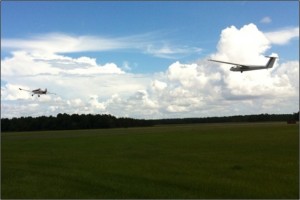
by Matt Bocchino
Many people who aren’t familiar with general aviation (which is loosely defined as all flying that doesn’t include military or airlines) tend to consider those who like to fly around in little planes, well…crazy. Untrue as that may be, imagine what those people may think of someone who flies around in a plane without an engine. There’s actually a group at Herlong Recreational Airport dedicated solely to that unique type of aviation: the North Florida Soaring Society (NFSS).

The NFSS, also known around the airfield as the Glider Club, began operating at Herlong in 1967. Gliders are light, unpowered (engineless) aircraft specially-designed to make the most efficient use of the air around them. It’s pretty fascinating to see one operate: a powered aircraft takes off and literally tows the glider into the sky behind it. When the pair reach sufficient altitude, the glider pilot pulls a lever in his cockpit to release the tow cable from his plane and he’s on his own. But if you think that the glider is then on a direct (albeit gradual) course for the ground, you wouldn’t be entirely accurate.
A NFSS member once told me that he soared from Herlong to Tallahassee and back in one afternoon without landing. The key is locating thermals, or rising masses of warm air, that can be found under those big puffy clouds in the summer, or above a large parking lot, trailer park, mall, etc. A glider pilot can ride a thermal higher than 8,000 feet, according to the NFSS website. By using thermals and a technique known as “cloud surfing” gliders can stay airborne for long periods of time and travel long distances.
As a private pilot myself, I often wonder why in the world someone would want to fly gliders; I personally find great comfort in that engine thing. To get more insight, I spoke with Frank Benedetto, a glider pilot and member of the NFSS since 1994. Benedetto, who flew powered aircraft himself at one time, says that piloting gliders is better for two reasons: the cost and the skill required. With no engine to maintain and no fuel to pay for, the cost aspect is fairly self-explanatory. He expounded on the latter part a little more:
“Gliding makes you a better pilot,” he said. “It improves your skill, your efficiency, and your ‘stick and rudder’ coordination. It also gives you a much better understanding of weather.”
Glider pilots have to have quick thinking skills and problem-solving abilities because they must be ready to land on short notice. Without those rising air masses, the glider is coming down whether the pilot is ready or not. When I asked him what happens when a glider pilot can’t find thermal activity, Benedetto responded with a chuckle: “That takes a little bit of skill too.”

Benedetto is one of those Herlong tenants who has witnessed or actively partaken in aviation history. As a NASA employee in the latter half of the 1960s, he manned one of the space agency’s tracking ships positioned around the world during manned missions. He would set up a voice link with the Apollo spacecraft as it orbited the Earth or traveled to the moon, establish a connection with the astronauts and pass them onto the CAPCOM (Capsule Communicator) at Mission Control in Houston. For the famed Apollo 11 moon landing, he managed an 85-foot deep-space tracking dish on the island of Antigua. The dish directly downloaded telemetry data from the Lunar Module Eagle as Neil Armstrong landed it on the moon’s surface. Another interesting side note: because of the role he played in the mission, Benedetto was able to procure Armstrong’s autograph, as well as those of the other two Apollo 11 crewmembers. Getting the famous “First Man” to sign anything was a nearly impossible task in the latter half of his life. Not to mention that Armstrong, too, was an avid glider pilot until he passed away in 2012.
Soaring is just one of the many activities at Herlong Recreational Airport that make it a truly unique place to fly. If you’re interested in learning more about the Soaring Society, feel free to give them a call at (904)-373-8325 or visit their website at www.nfsoaring.org. You’re also welcome to stop by the airfield and see them operating for yourself, or come talk to some of our interesting tenants like Frank. Most of Herlong’s population loves to spread their love of aviation!
